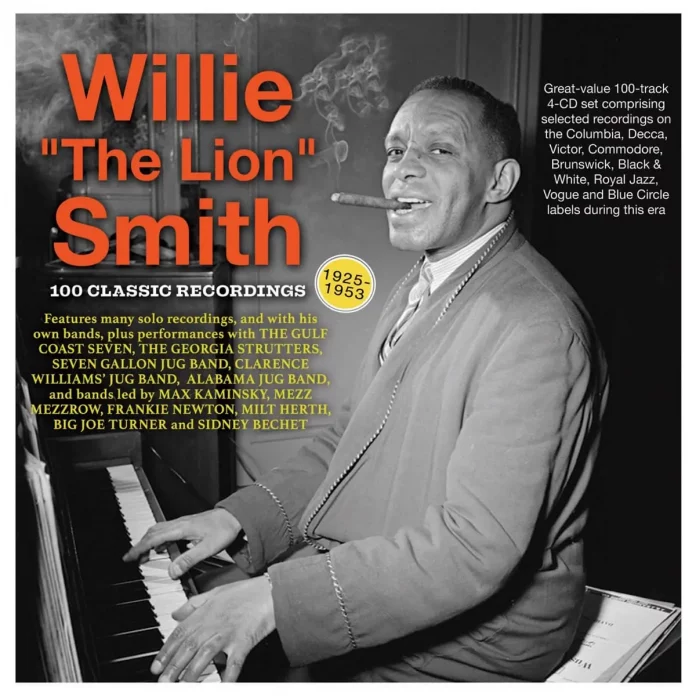With his trademark Derby hat and big cigar, a flamboyant extrovert personality, sizzling displays of showcase keyboard wizardry and a ready flow of entertaining anecdotes (usually celebrating his own prowess), Willie was one of the most colourful live performers in jazz. His active mind turned to wide-ranging interests – he studied Judaism, classical music and acted in a Broadway play. Above all, he was an exceptionally gifted pianist.
His innovative style, rooted in ragtime and stride, was enriched by intriguing harmonic developments and powerfully driving rhythmic patterns, said to have attracted Tatum’s interest. There’s also discernible impressionistic classical piano influence, blending at times with the surging jazz rhythms, notably in his best-known Echoes Of Spring – just one of the 29 Smith compositions featured here.
An enthusiastic showman, he loved to entertain live audiences, and opted for revues, shows and numerous stints in New York’s clubland rather than regular visits to the recording studio. So, compared with James P. Johnson and Fats Waller, fellow founding fathers of stride piano back in the 20s, his early recordings are somewhat sparse, and he became less widely known. It was 1935 before he recorded under his own name (Willie The Lion And His Cubs) and 1939 before his first solo recordings were issued.
This four-CD compilation contains 100 tracks recorded 1925-53, featuring Smith in a variety of musical settings, both as an intriguing soloist and composer, and as a strongly supportive sideman with a host of top jazz names.
On CD1 we hear him in the archaic but infectiously swinging jug bands dear to Clarence Williams, with strong contributions from the dependable pairing of Ed Allen and Cecil Scott, besides hot, small-group swing from his Cubs (including an interesting group version of Echoes Of Spring) and from Mezz Mezzrow’s Swing Gang (Mutiny In The Parlour, The Panic Is On).
CD2 includes notable contributions from Frankie Newton and Buster Bailey in Blues Why Don’t You Let Me Alone? and the appealing Achin’ Hearted Blues. After a couple of strange tracks with a dominant organist, Milt Merth, Willie delivers two charming pieces in semi-classical etude style, Passionette and Morning Air. There’s a similar feel to Fading Star and Rippling Waters a year later in his first-issued solo recordings, which also include a spectacular breakneck Fingerbuster and clever but perhaps over-busy arrangements which somewhat obscure the striking melodies of Between The Devil And The Deep Blue Sea and Tea For Two. In contrast, The Lion lays down full and expressive blues backing for blues singer Big Joe Turner.
More riches follow from 1941 with our man strongly propulsive in the wonderful sessions with Sidney Bechet and Charlie Shavers, which close the outstanding CD2 and extend into CD3, with Strange Fruit, Twelfth Street Rag, Lady Be Good and What Is This Thing Called Love? Eight years later, on tour in France, and in fine form, Smith recorded eight solos, all interesting originals apart from a demonstration of breakneck speed stride in Twelfth Street Rag. Portrait Of The Duke returns the compliment for Ellington’s Portrait Of The Lion written in earlier years. Soon after, Willie recorded more solos and some entertaining quartet tracks with the unusual pairing of Buck Clayton and the French clarinettist/bandleader Claude Luter, with whose band Bechet was now working. These stretch over into CD4.
With the Lion back in New York in 1950, more fine solos are featured, including Conversations On Park Avenue (another intriguing “sound picture”), Just One Of Those Things and a cleverly arranged Hallelujah. The compilation bows out in 1953 with a selection of solos from an early 10-inch LP tribute to Smith’s old friend from early days, James P. Johnson, with some interesting fresh twists.
The Lion lived another 20 years, busily active on live circuits in his own colourful musical world, and ignoring developing post-war trends such as bop and revivalism. The informative and full notes justify drawing the line at 1953 by explaining that his subsequent work had “something of a retrospective flavour”. I find this a tad dismissive, and I think The Lion would have roared!
But it would be churlish to find serious fault in this generous and fascinating tribute to a remarkable artist whose work influenced jazz widely, admired by pianists as diverse as Thelonious Monk, Joe Bushkin, Mel Powell and (particularly) Duke Ellington, who described Smith as “the greatest influence of all the great jazz piano players who have come along. He has a beat that stays in the mind!” Hear it for yourself in this absorbing release.
Discography
CD1: 26 tracks, NY, 1925-37, with The Gulf Coast Seven, The Georgia Strutters, Seven Gallon Jug Band, Clarence Williams Jug Band, Mezz Mezzrow Orch/Swing Gang, Smith’s Cubs (73.56)
CD2: 25 tracks, NY, 1937-41, with Smith’s Cubs/Orchestra, Milt Herth Trio, Big Joe Turner Duo, Sidney Bechet And His New Orleans Feetwarmers/Trio, piano solos (71.04)
CD3: 24 tracks, NY and Paris, France, 1941-49, with Bechet’s Feetwarmers, Max Kaminsky’s Band, Smith’s Cubs, quartet and solo (70.40)
CD4: 25 tracks, Paris and NY, 1949-53, with quartet, solo and Smith’s Orchestra (70.33)
Smith (p, v) on all tracks, with full discographical information, including personnels. Personnels include Buster Bailey, Clarence Williams, Mezz Mezzrow, Ed Allen, Cecil Scott, Max Kaminsky, Frankie Newton, Bud Freeman, Pete Brown, Big Joe Turner, Sidney Bechet, Charlie Shavers, Buck Clayton and Claude Luter.
Acrobat ACQCD7165
















